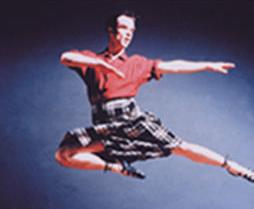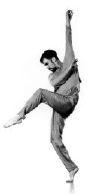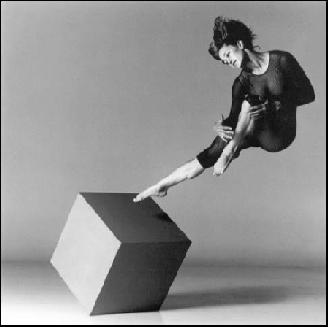Elizabeth Venable
May, 2000
This is an essay I wrote for a class recently and which includes some quotes/information from some of my many ongoing interviews. This particular essay is driven by 2 interviews I did with Sean Curran, in January of 2000, and one email interview with Ashley Roland, in April 2000.

Mark Howard, the director of Trinity Company, has been perhaps the most effective voice and force for change within the Irish dance community in recent times. His work laid the foreground for such large scale professional works as Riverdance, and his work has been consistantly cited as the inspiration for several of the works of the aforementioned show. Trinity Company was one of the first and is certainly one of the most successful professional Irish dance groups. Trinity has been lauded by the press and has toured both the United States and Europe. Trinity school has also won numerous World Dance Drama and Ceili/Choreography medals.
The aims of Trinity�s choreography seem quite revolutionary in terms of conventional Irish dance standards. Since its creation in 1989, it has fused Irish with several styles such as African American tap in Turf, 1994, and East Indian and African traditions in Umoja, 1992. Trinity has also invited several modern choreographers, including Sean Curran and Ashley Roland. Although very innovative in approach, even Trinity has a large body of restrictions which it places upon its acting choreographers. Howard is primarily interested in work which is "progressive yet traditional"; work which pushes the edges and expands what can be viewed as Irish dance, but which does not alienate its audience and which provides what is expected by that group. In 1999 and 2000, respectively, Roland�s O�Reely and Curran�s Curran Event debuted with Trinity Company.
Sean Curran began his training with Josephine Moran, ADCRG, of the Fitzmaurice-Moran school in Boston. In the 60s, he was a Minor Boy�s (Irish Dance) Champion. He was noticed during his stay at NYU�s Tisch School for the Arts by Bill T. Jones and Arnie Zane, and was later a 10-year company member. He later became more of an expert at body percussion as a member of Stomp. Since the middle of the 1990s, he has choreographed for and managed his own company, which performs a wide variety of primarily modern/postmodern works.
In 1997, he was commissioned by Celebrate Brooklyn to create what he later described as a work "poking fun at Riverdance and Lord of the Dance," and which discuses intra-Irish personal relations and Irish culture, Folk Dance for the Future. This work, which poked fun at such wide-ranging concepts as gender roles in Irish society and the competitive mind set, while maintaining a general sense of community, was a gigantic success. It featured an anecdotal/collage style of choreography which allowed both dancing baby-dolls of interesting parentage, an improvisational mocking-style solo from Curran company member Heather Walden, and Curran�s original kilt from his competitive days, revived and revitalized. These vignettes were combined to a very amusing and interesting end. Ever since the creation of this work, his name has been increasingly connected with art of an Irish nature. It was thus not surprising that he recently created a work for Trinity, Curran Event.
Curran Event merges a "Cunningham-like use of space" with traditional circling and linear shapes, and brings body percussion and hardshoe footwork together. The work, which features 10 dancers, is broken into sections, each featuring different aspects of the aforementioned concepts. When working with the body percussion, he mirrors the arms and legs, alternating slapping with trebles, using similar rhythms for each.
Curran�s extensive knowledge of Irish dance and his connection to the Irish community enables him to grasp concepts of interest in a manner which is realistic and novel. It is his understanding of the nuances of Irish dance and culture which make his works a pleasure to watch-- he is able to recognize and evaluate certain themes and trends within the dance, and distort them for his own personal goals. In fact this is what he is primarily interested in when making his "Irish" works. As he said to me, "I am a person who believes that rules are meant to be broken. And I am, as a choreographer, interested in invention, ingenuity, with my choreography. Certainly with the Trinity company, and my own group, I was thinking, 'How do you speak an old language in a new way?'. So it doesn�t get stagnant. Irish step dancing is so evolved now, in terms of what people are doing with their feet and legs. I think that the next step will be to incorporate upper body [movements], and you�re seeing it more and more in the choreography in the folk or what I call the figure dancing." It is his ability to recognize the developments which have been made, as well as those which are needed, which makes his perspective valuable, and it is the complexity of his thoughts which make his work interesting.
Ashley Roland had not worked with Irish step dancers before creating O�Reely. She has been a member of Momix and ISO Dance, and now runs BodyVox, with her husband, Jamey Hampton. She has also choreographed works for such prestigious companies as Oregon Ballet Theater, Geneva Opera Ballet, and Ballet Pacifica. During their interlinking careers, Roland and Hampton have choreographed for several popular musical artists, as well as for the fashion designer, Issey Miyake. They have also choreographed for the Academy Awards, and have won Emmys for their work.
Roland was specifically not inspired by traditional patterns, having little to no familiarity with the form in general. She was commissioned by Mark Howard to 'create a piece with humor', and had been given 'the challenge of bringing [her] contemporary background into their milieu'.Having worked with humor before, and with other Chicago area groups (notably River North), she seemed a somewhat logical choice. Apparently, several choreographers had been given the same challenge, but were unable to create a work to his liking. They had 'strayed too far from the Irish form and the girls were [left to do] movements that were alien and brand new to them'. She, like Sean, was somewhat pressured to include more of an Irish influence than she would have other wise liked, and there was something of a conflict over her choice of music. In the end, she chose Mozart, which gave 'the mostly Irish audiences a taste of something different but not too aberrant'. Roland was somewhat reticent to discuss the general meaning of the work, the general feeling of which might be characterized as a half-malicious and farcical romp filled with jokes and trio/duet work. Her main intent was for it to be a 'delight for eye and the spirit of the viewer'. That the work did not contain much of "heft" was apparently intended.
She apparently exercised little control over the steps themselves, vocally giving the girls rhythms and then having them "fill in the footwork". Possibly her apparent discomfort with working within the form led her to only slightly feature rhythmic components in her work. It was 'the only piece [she] ever choreographed where [she] could not demonstrate all of the elements'--This may have been a bit limiting. She fixated a bit upon such things as arms and lifts, some of which came off a bit shakily to me as an audience member. In the beginning of O�Reely, her attempts with arms were quite successful, however, perhaps because the limbs were isolated and used much as the legs would have been. However, the attempts at whole body integration were perhaps too sudden, leading to an unintended distortion of technique, which she may or may not have been aware of.
It is interesting to see the attempts of one who is not familiar with the culture she is working within to create competent art. Ultimately, however, I am far more partial to and biased towards the art of Sean Curran, not only because of its more human dimensions, but because he has inherent knowledge of the form which cannot really be accessed by the "outsider". I believe it is almost impossible to create works which resonate within the Irish dancing community without having been a member of it. There are several very distinct factors which limit the creation of art in Irish step dancing, aside from technique (especially, of course, the lack of torso), the problems caused by which can obviously be discerned by an outsider. Irish dancers are very limited in their concepts of gender; there are very extreme dualities in the presentation of male and female roles, to the point where certain sexes are not allowed to work within certain time signatures, which must be comprehended to work within. The extreme musicality of Irish dancers must be utilized--it is a waste not to make use of what are perhaps their most remarkable skills. I find it difficult to believe that these and other issues could be dealt with by one who has never even taken class in the movement, let alone competed or grown up in an Irish community.
It is, though, very important that new ideas regarding technique and choreography enter the Irish dancing world. This may be accomplished by inviting "foreigners" such as Ashley Roland to produce works, but, in the end, it will be those within the sphere of the art who need to perpetuate and disperse these new concepts, because the length of time any one primarily modern or ballet choreographer will stay with the form is limited. There are certain problems with the novelty of the current incarnation of public Irish dance which may keep other artists from working for a large period of time with the form. Certain recent manifestations of the dance, while popular with mass audiences, are not necessarily attractive as to artists or seriously seen as "art"-- this of course limits the types of choreographers who are willing to create work for the Irish community. There are also limitations, it seems in the capacity of the general public, to see any one artist or choreographer in more than one way. Sean Curran is doubtful that he will produce many more Irish or Irish-influenced works-- ever since Folk Dance For The Future, his name has become more and more aligned with the currently popular Irish step, and it has become frustrating for him, of course, primarily a modern choreographer, to try to get commissions as of late which are not of an "Irish" nature. He worries that his legacy will be distorted by such a focus upon his 'Irish voice'. This stifling feeling keeps him from producing more step-dance related work. Novelty may also die off in the end, restricting further the numbers of artists who are interested in working within the form. Thus, in the end, it must be the Irish dancers themselves who are introducing new concepts and who are active in creating and perpetuating a "new" feeling of modernity. Other influences may be inconstant, short-acting, and, thus, relatively unimportant as instigators of true change.
Unfortunately, most Irish dancers are not trained in other art forms, let alone dance, and thus may not have the prowess to make work which is relevant to a great number of people (without excessive displays of pure technical bravado). Irish dance training may interfere, furthermore, with the accumulation of the technique of a good number of other styles of western dance. This is especially true with regards to ballet, which, although similar, in terms of ancestry, to step dance, has mechanically diverged from the common root to the point where the differences between the two are difficult to reconcile. Although modern dance does not offer the same conflicts, it is still difficult to merge the two to create an amalgam which is not technically distracting, especially to an Irish dance audience. Any choreographer working within the form must be excessively sensitive to the conflicts of technique which arise, and must develop systems which account for these problems, or else face showing a work which is so far removed from "good" Irish dance technique as to be unrecognizable, except in a general sense. Although movement which is not distinguishable as being one particular style is certainly valuable within the grand sphere of dance, it has little role in a work of fusion, where the point is to expand upon a decided idea, or meld a set of ideas.
The constraints choreographers face when working with Irish dance choreography can be numerous. Hopefully there will be several more developments within the sphere of the art which allow it to be enlarged. The pace of expansion will most likely not be the most radical, as most directors of companies will most likely not even want to work at the slightly "advanced" pace that Howard favors. If, however, there are more Irish and non-Irish choreographers steadily working to expand the scheme of the dance, such as Roland and Curran, progress in general will probably be hard to stop.

